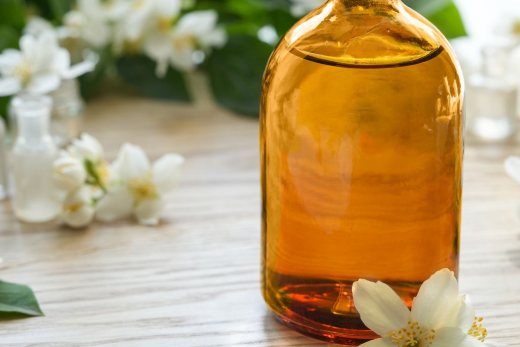From the very first spray, top notes immediately capture our attention, playing a crucial role in our perception and appreciation of a fragrance. These first scents, often fresh and volatile, are designed to seduce and intrigue, establishing the first olfactory impression that can strongly influence our purchasing decision. This article explores how top notes not only define the identity of a fragrance, whether it be of a women's fragrance or a men's fragrance, but also how they shape our personal experience with perfume, revealing their subtle yet powerful power in the art of perfumery.

Understanding your perfume's top notes
Top notes are the first scents we perceive immediately after applying a fragrance. They are crucial because they constitute the first olfactory impression, often decisive in a fragrance's appeal. Volatile and ephemeral, these notes evaporate quickly, but their initial impact is essential in capturing interest and paving the way for the next scent. the heart notes et more sustainable.
Regarding their composition, top notes typically include perfume ingredients light and refreshing such as:
- Citrus fruits: Lemon, bergamot, mandarin, and grapefruit, which bring a lively and tangy freshness.
- Fresh Herbs: Basil, mint, and rosemary, providing clean, aromatic accents.
- Green notes: Blackcurrant leaf and cut grass, evoking the freshness and purity of nature.
- Light fruits: Apple, pear, and melon, which give a subtle and slightly sweet sweetness.
- Sweet spices: Cardamom and pink pepper, which introduce a spicy but discreet dimension.
These elements are selected for their ability to manifest quickly and disappear, giving way to more robust and persistent notes. They play a fundamental role not only in the initial attraction but also in the overall construction of the olfactory architecture of a perfume.

The impact of top notes on perfume perception
Top notes play a vital role in forming the first olfactory impression of a perfume. Light and ephemeral, they are the first scents felt when applying perfume and are crucial in capturing attention and arousing interest. Thanks to their high volatility, top notes immediately emit a distinct fragrance that often defines the initial appeal of the perfume. These first notes can evoke a multitude of sensations, ranging from the freshness of citrus fruits to the liveliness of aromatic herbs, which play a determining role in the user's perception and appreciation of the fragrance.
As the top notes evaporate, they gradually give way to the heart notes, defining the central character of the fragrance. This transition is an olfactory evolution and an invitation to discover the deeper and more complex layers. The heart notes then take over, offering richer, lingering aromas that settle on the skin for a lasting experience. This progression is essential for the evolution of the perfume, where each phase builds in harmony with the others, forming a captivating final bouquet. Discover how different types of perfume contribute to this olfactory symphony.
Examples of Popular Top Notes and Their Effects
Top notes are the keystone of the initial olfactory experience of a perfume. Here are some examples of popular top notes and the impact they have on perfumes:
- Lemon and bergamot: These citrus fruits provide immediate freshness and zesty liveliness, often used to inject an energizing boost from the first seconds of application. Their natural acidity awakens the senses and establishes a refreshing ambiance.
- Lavender and mint: These herbs are synonymous with cleanliness and freshness. Lavender, with its soft, slightly floral undertones, and mint, known for its invigorating and fresh effect, are ideal for perfumes that seek to convey a feeling of purity and naturalness.
In addition to these ingredients, here is a detailed list of other top notes frequently used in perfumery:
- Grapefruit: Offers a tangy and bitter touch that can energize an entire fragrance.
- Basil: Provides a green, slightly spicy nuance, enriching flavors with herbaceous complexity.
- Pink Pepper: Introduces a spicy yet fruity dimension, adding an intriguing contrast to traditional top notes.
- Neroli: Distilled from orange blossoms, neroli combines both floral and citric elements, bringing delicate sophistication.
Blackcurrant leaf: Known for its green and fruity aromatic profile, it gives a much appreciated touch of bucolic freshness.
These components are chosen not only for their immediate impact on the senses, but also for the way they set the stage for background notes, thus contributing to the complexity and overall balance of the perfume.

How to choose a perfume based on its top notes
Choosing a perfume that suits you can greatly depend on the initial reaction to the top notes. Here are some tips for effectively testing a perfume and determining whether its top notes suit you:
Tips for testing a perfume
- Don't rush: When testing a perfume, spray it on a perfumer's pad or directly on the skin and let it express itself for a few minutes. The top notes are the first scents you will perceive, they will evaporate quickly, so take the time to fully appreciate them.
- Test in the right conditions: Avoid testing too many scents at once, as your nose can become insensitive to the subtle differences. Ideally, test up to three scents per visit, leaving time between each trial for your olfactory sense to reset.
Matching personal preferences
- Identify what you like : Think about the smells you enjoy in everyday life — this can help you choose top notes. If you like the smell of citrus in your kitchen, you might enjoy scents with lemony top notes. If you're drawn to the smell of fresh grass or gardens, look for perfumes with green or herbaceous top notes.
- Consider the occasion : Top notes that are suitable for everyday use may not be ideal for a night out or special event. Perfumes with light, fresh top notes may be perfect for daytime, while those with spicy or exotic notes may be more appropriate for evenings.

By following these tips, you can more easily identify a fragrance whose top notes resonate with your personal preferences and fit your lifestyle. First impressions are often decisive when choosing a perfume, so pay particular attention to top notes when testing.
The influence of top notes on the longevity and sillage of the perfume
Top notes, although volatile and ephemeral, play a significant role not only in the initial attraction of a perfume but also in its durability and sillage.
Sustainability
The top notes are the first to be felt but also the first to evaporate. Although they don't linger as long as the middle and base notes, their quality can influence how subsequent notes unfold. A good balance in the formulation of top notes can help prolong the presence of the middle notes, making a smoother transition and strengthening the overall perception of the fragrance on the skin. So, even if they are fleeting, the top notes set the stage for a prolonged olfactory experience.
Sillage
The trail of a perfume, that is to say the aromatic imprint it leaves in the air when a person passes, is strongly impacted by the top notes. Although these notes are quickly replaced by more lasting notes, they are crucial for the first impression of the trail. A perfume with powerful, distinctive top notes can create an impressive initial scent and attract attention, even if those notes only last a short time. Top notes set the “tone” of the scent and can greatly affect how the fragrance is perceived by others around you from the very first moments.
In summary, top notes have a substantial impact on the durability and sillage of a fragrance, often determining a person's first interactions with the fragrance and playing a crucial role in the overall appeal and memorability of the fragrance.




